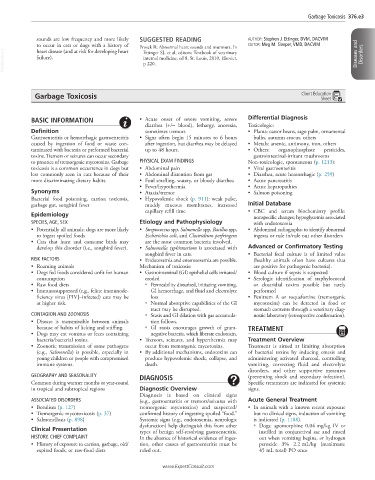Page 794 - Cote clinical veterinary advisor dogs and cats 4th
P. 794
Garbage Toxicosis 376.e3
sounds are low frequency and more likely SUGGESTED READING AUTHOR: Stephen J. Ettinger, DVM, DACVIM
to occur in cats or dogs with a history of Prosek R: Abnormal heart sounds and murmurs. In EDITOR: Meg M. Sleeper, VMD, DACVIM
VetBooks.ir failure). Ettinger SJ, et al, editors: Textbook of veterinary Diseases and Disorders
heart disease (and at risk for developing heart
internal medicine, ed 8, St. Louis, 2010, Elsevier,
p 220.
Garbage Toxicosis Client Education
Sheet
BASIC INFORMATION • Acute onset of severe vomiting, severe Differential Diagnosis
diarrhea (+/− blood), lethargy, anorexia, Toxicologic:
Definition sometimes tremors • Plants: castor beans, sago palm, ornamental
Gastroenteritis or hemorrhagic gastroenteritis • Signs often begin 15 minutes to 6 hours bulbs, autumn crocus, others
caused by ingestion of food or waste con- after ingestion, but diarrhea may be delayed • Metals: arsenic, antimony, iron, others
taminated with bacteria or preformed bacterial up to 48 hours. • Others: organophosphate pesticides,
toxins. Tremors or seizures can occur secondary gastrointestinal-irritant mushrooms
to presence of tremorgenic mycotoxins. Garbage PHYSICAL EXAM FINDINGS Non-toxicologic, spontaneous (p. 1213):
toxicosis is a common occurrence in dogs but • Abdominal pain • Viral gastroenteritis
less commonly seen in cats because of their • Abdominal distention from gas • Diarrhea, acute hemorrhagic (p. 259)
more discriminating dietary habits. • Foul smelling, watery, or bloody diarrhea • Acute pancreatitis
• Fever/hypothermia • Acute hepatopathies
Synonyms • Ataxia/tremor • Salmon poisoning
Bacterial food poisoning, carrion toxicosis, • Hypovolemic shock (p. 911): weak pulse,
garbage gut, songbird fever muddy mucous membranes, increased Initial Database
capillary refill time • CBC and serum biochemistry profile:
Epidemiology nonspecific changes; hypoglycemia associated
SPECIES, AGE, SEX Etiology and Pathophysiology with endotoxemia
• Potentially all animals; dogs are more likely • Streptococcus spp, Salmonella spp, Bacillus spp, • Abdominal radiographs: to identify abnormal
to ingest spoiled foods Escherichia coli, and Clostridium perfringens ingesta or rule in/rule out other disorders
• Cats that hunt and consume birds may are the most common bacteria involved.
develop this disorder (i.e., songbird fever). • Salmonella typhimurium is associated with Advanced or Confirmatory Testing
songbird fever in cats. • Bacterial fecal culture is of limited value
RISK FACTORS • Endotoxemia and enterotoxemia are possible. (healthy animals often have cultures that
• Roaming animals Mechanism of toxicosis: are positive for pathogenic bacteria).
• Dogs fed foods considered unfit for human • Gastrointestinal (GI) epithelial cells irritated/ • Blood culture if sepsis is suspected
consumption eroded • Serologic identification of staphylococcal
• Raw food diets ○ Permeability disturbed, initiating vomiting, or clostridial toxins possible but rarely
• Immunosuppressed (e.g., feline immunode- GI hemorrhage, and fluid and electrolyte performed
ficiency virus [FIV]–infected) cats may be loss • Penitrem A or roquefortine (tremorgenic
at higher risk. ○ Normal absorptive capabilities of the GI mycotoxins) can be detected in food or
tract may be disrupted. stomach contents through a veterinary diag-
CONTAGION AND ZOONOSIS ○ Stasis and GI dilation with gas accumula- nostic laboratory (retrospective confirmation).
• Disease is transmissible between animals tion follows.
because of habits of licking and sniffing. ○ GI stasis encourages growth of gram- TREATMENT
• Dogs may eat vomitus or feces containing negative bacteria, which liberate endotoxin.
bacteria/bacterial toxins. • Tremors, seizures, and hyperthermia may Treatment Overview
• Zoonotic transmission of some pathogens occur from tremorgenic mycotoxins. Treatment is aimed at limiting absorption
(e.g., Salmonella) is possible, especially in • By additional mechanisms, endotoxins can of bacterial toxins by inducing emesis and
young children or people with compromised produce hypovolemic shock, collapse, and administering activated charcoal, controlling
immune systems. death. vomiting, correcting fluid and electrolyte
disorders, and other supportive measures
GEOGRAPHY AND SEASONALITY DIAGNOSIS (preventing shock and secondary infection).
Common during warmer months or year-round Specific treatments are indicated for systemic
in tropical and subtropical regions Diagnostic Overview signs.
Diagnosis is based on clinical signs
ASSOCIATED DISORDERS (e.g., gastroenteritis or tremors/seizures with Acute General Treatment
• Botulism (p. 127) tremorgenic mycotoxins) and suspected/ • In animals with a known recent exposure
• Tremorgenic mycotoxicosis (p. 37) confirmed history of ingesting spoiled “food.” but no clinical signs, induction of vomiting
• Salmonellosis (p. 898) Systemic signs (e.g., endotoxemia, neurologic is indicated (p. 1188).
dysfunction) help distinguish this from other ○ Dogs: apomorphine 0.04 mg/kg IV or
Clinical Presentation types of benign self-resolving gastroenteritis. instilled in conjunctival sac and rinsed
HISTORY, CHIEF COMPLAINT In the absence of historical evidence of inges- out when vomiting begins, or hydrogen
• History of exposure to carrion, garbage, old/ tion, other causes of gastroenteritis must be peroxide 3% 2.2 mL/kg (maximum:
expired foods, or raw-food diets ruled out. 45 mL total) PO once
www.ExpertConsult.com

